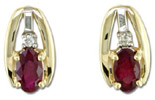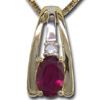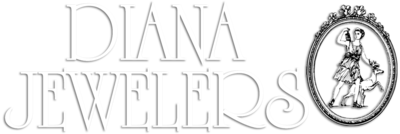 Rubies have always been treasured for their regal beauty. The ruby is the red variety of the corundum family, which includes sapphire, and is the most valuable. Traces of chromium found in the ruby's crystal structure cause this blazing gem's orangey to purplish red hue. Fine quality rubies are extremely rare. The color of the gem dictates its value.
Rubies have always been treasured for their regal beauty. The ruby is the red variety of the corundum family, which includes sapphire, and is the most valuable. Traces of chromium found in the ruby's crystal structure cause this blazing gem's orangey to purplish red hue. Fine quality rubies are extremely rare. The color of the gem dictates its value.In their rough state, rubies contain various imperfections. They may be in a form of color impurities and thin mineral inclusions called needles. Gemologists use these inclusions to distinguish ruby stones from substitutes or synthetics. Rubies are enhanced using a number of treatments, including using heat treatment, lattice diffusion, fracture filling, and lead-glass filling.
 One of the most common treatments for rubies is heat treatment. Ruby stones are exposed to a very high temperature for the purpose of altering their color and clarity. This primarily removes the purplish coloration of the gem and renders a pure and richer hue. Heating also dissolves or minimizes the needle-like inclusions, making the stone more opaque. Another use of the heating is to improve the asterism, or star-like effect, in the ruby.
One of the most common treatments for rubies is heat treatment. Ruby stones are exposed to a very high temperature for the purpose of altering their color and clarity. This primarily removes the purplish coloration of the gem and renders a pure and richer hue. Heating also dissolves or minimizes the needle-like inclusions, making the stone more opaque. Another use of the heating is to improve the asterism, or star-like effect, in the ruby. Lattice diffusion is a relatively new treatment which involves adding coloring elements into the actual molecular structure of stone to further accentuate its hue. Rubies are heated at a very high temperature with the element beryllium. Since beryllium is smaller than the elements that make up the ruby, it is able to penetrate much deeper into the stones, successfully changing their color. Lattice diffusion is a stable and permanent treatment under normal handling.
 Another method, fracture filling, is occasionally used in rubies. Small surface-breaking fissures or cavities may be filled with colorless glass or fluxes during the heat treatment process. Using this procedure reduces the visibility of fissures, thus enhancing the apparent clarity and color of rubies.
Another method, fracture filling, is occasionally used in rubies. Small surface-breaking fissures or cavities may be filled with colorless glass or fluxes during the heat treatment process. Using this procedure reduces the visibility of fissures, thus enhancing the apparent clarity and color of rubies. Lead glass filling is a more recent innovation which started around 2004. Low quality, fractured rubies or corundum stones characterized with large numbers of fractures are subjected to simple heating and filled with high-lead-content glass. This reduces the visibility of the fractures, making the stone appear more transparent. Lead-glass filled rubies, also referred to as composite rubies, may contain more glass than precious stone and are far less valuable than traditionally glass filled rubies. Compared to other treatments, composite rubies are less durable and should be handled with care. The FTC requires a detailed disclosure for composite rubies including special care requirements to preserve the appearance of the stone.
